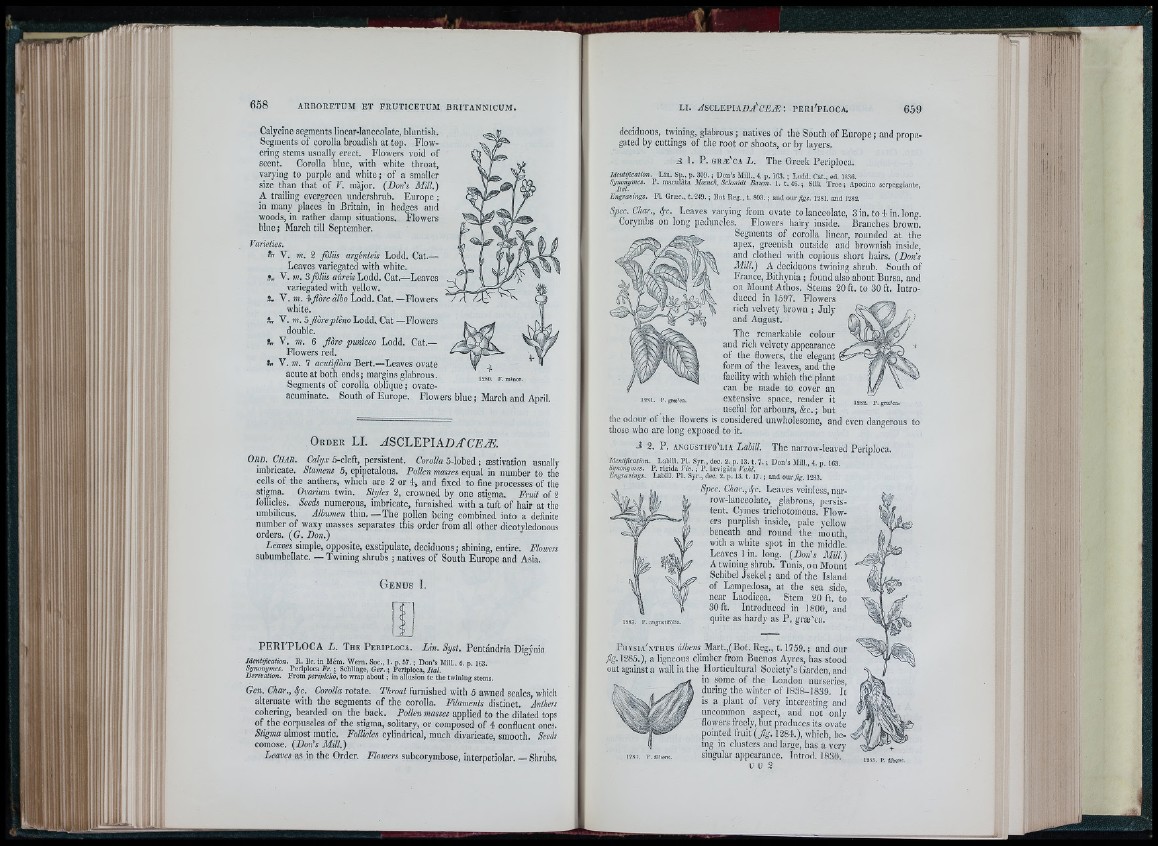
Calycine segments linear-Ianceolate, bluntish.
Segments oi“ corolla broadish at top. Flowering
stems usually erect. Flowers void of
scent. Corolla blue, with white throat,
varying to purple and white; of a smaller
size than that of V. major. (Don’s Mill.)
A trailing evergreen undershrub. Furope ;
in many places in Britain, in hedges and
woods, in rather damp situations. Flowers
blue; March till September.
Varieties.
^ V. m, 2 ßliis argenteis Lodd. Cat.—
Leaves vai'iegated with white.
V. VI. 3ßliis aúreis Lodd. Cat.—Leaves
variegated with yellow.
irr V. 771. 4ßbi'eälbo Lodd. Cat. —Flowers
white.
irr V. m. 5ßbrepleno Lodd. Cat —Flowers
double.
ÍW V. in. 6 ßore puniceo Lodd. Cat.—
Flowers red.
in V. in. 7 acutiflhra Bert.—Leaves ovate
acute at both ends; margins glabrous.
Segments of corolla oblique; ovateacuminate.
South of Furope. Flowers blue; March and April.
O r d e r LI. «4SCLEPIAL)aTCEÆ.
O b d . C h a r . Calyx S-cleft, persistent. Corolla S-Iobed ; æstivation usually
imbricate. Stamens 5, epipetalous. Pollen masses equal in number to the
cells of the antliers, which are 2 or 4, and fixed to fine processes of the
stigma. Ovarmm twin. Styles 2, crowned by one stigma. Fruit of 2
follicles. Seeds numerous, imbricate, furnished with a tuft of hair at the
umbilicus. Albumen th in .— The pollen being combined into a definite
number of waxy masses separates this order from all other dicotyledonous
orders. {G. Bon.)
Leaves simple, opposite, exstipulate, deciduous ; shining, entire. Flowers
subumbollate. — Twining shrubs ; natives of South Europe and Asia.
G e n u s I.
P E R I'PLO CA L. T h e P e r í p l o c a . Lin. Syst. Pentándria Digynia,
Identification. R. Br. in Mém. Wern. Soc., 1. p. 57.; Don’s Mill.. 4. p 1G3
Synonymes. Períploca Fr. ; Schlinge, Ger. ; Períploca, Ital.
Derivation. From peripleJcd, to wrap a b o u t; in allusion tc the twining stems.
Gen. Char., 4c. Corolla rotate. Throat furnished with 5 awned scales, which
alternate with the segments of the corolla. Filaments distinct. Anthers
cohering, bearded on the back. Pollen masses applied to the dilated tops
of the corpuscles of the stigma, solitary, or composed of 4 confluent ones.
Stigma almost mutic. Follicles cylindrical, much divaricate, smooth. Seeds
comose. (Don's Mill.)
Leaves as in the Order. Floivers subcorymbose, interpetiolar. — Shnibs,
deciduous, twining, glabrous ; nativesof the South of Europe ; and propagated
by cuttings of the root or shoots, or by layers,
A 1. P. g ræ 'c a L. The Greek Periploca.
Identification. Lin. Sp., p. 309. ; Don’s Mill., 4. p. 163. ; Lodd. Cat., ed 1830.
Syiionymes. P. maculàta Moench, Schmidt Baum. 1. t.4G. ; Silk T re e ; Apocino serppggiante.
Engravings. Fl. Græc., t. 249. ; Bot Reg., t. 803. ; and o u r ^ s . 1281. and 1282.
Spec. Char., S/c. Leaves varying from ovate to lanceolate, 3 in. to 4 in. long.
Corymiis on long peduncles. Flowers hairy inside. Branches brown.
Segments of corolla linear, rounded at the
apex, greenish outside and brownish inside,
and clothed with copious short hairs. {Don's
M i l l . ) A deciduous twining shrub. South of
France, Bithynia ; found also about Bursa, and
on Mount Athos. Stems 20 ft. to 30 ft. Introduced
in 1597. Flowers
rich velvety brown ; July i rand
August. * je'])
The remarkable colour ^ ^ ¿
and rich velvety appearance
of the flowers, the elegant \
form of the leaves, and the
facility with which the plant
can be made to cover an
12S1. r. græ'ca. extcnsive space, render it iggg. p. groe'ca.
useful for arbours, &c. ; but
the odour of the flowers is considered unwholesome, and even dangerous to
those who are long exposed to it.
A 2. P. a n g u s t i f o ' l i a D a b i l l . The narrow-leaved Periploca.
Identification. Labill. PI. Syr., dec. 2. p. 13. t. 7. ; Don’s Mill 4 n lfi.3
Synonymes. P. rígida Viv. \ P. lævigàta Vahl.
Engravings. Labill. PI. Syr., dec. 2. p. 13. t. 17. ; and our fig. 1283.
Sjiec. C h a r . , S/c. Leaves veinlcss, narrow
lanceolate, glabrous, persistent.
Cymes tricbotomous. Flower.
s purplish inside, pale yellow
beneath and round the mouth,
with a white spot in the middle.
Leaves lin . long. {Don’s M i l l . )
A twining shrub. Tunis, on Mount
Scliibel jsekel ; and of the Island
of Lampedosa, at the sea side,
near Laodicea. Stem 20 ft. to
30 ft. Introduced in 1800, and
1283. P.angustifôiia. as hardy as P. græ'ca.
P i i y s i a 'n t h u s dlbens Mart.,(Bot. Reg., 1 . 1759.; and our
1285.), a ligneous climber from Buenos Ayres, has stood
out against a wall in the Horticultural Society’s Garden, and
- in some of the London nurseries,
during the winter of 1838-1839. It
is a plant of very interesting and
uncommon aspect, and not only
flowers freely, but produces its ovate
pointed fruit (y%. 1284.), which, being
in clusters and large, has a very
singular appearance. Introd. 1830.
u u 2